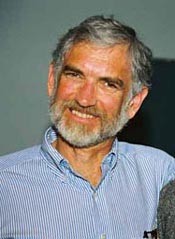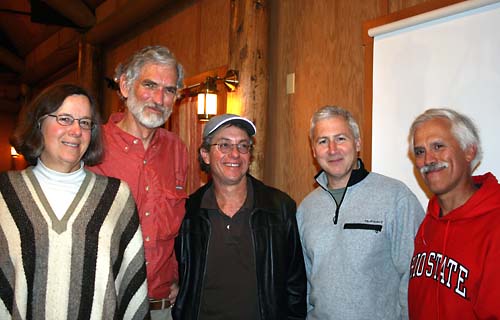USGS volcanologist Charles Bacon receives award at Crater Lake National Park
Crater Lake Institute
July 8, 2009
By ROBERT MUTCH
 USGS volcanologist, Dr. Charles Bacon |
Understanding the geologic history of a mountain is no easy task. It is something akin to making sense of weather or an ecosystem with their many interrelated components.
Mount Mazama, the progenitor of Crater Lake, has been under the scrutiny of geologists for just about 125 years now. The study of it’s domes, cones, plugs, dikes, intrusions, tuff, talus, till, shields, and other geological features have resulted in hundreds of thesis (for an M.A.), dissertations (for a Ph.D.), articles, guides, books, maps, photographs, and more.
Just a handful of geologists, however, have produced a large enough volume of work to add substantially to the understanding of Mount Mazama. So, like Joseph S. Diller did in the 1880’s and 1890’s, and Howel Williams did in the 1930’s and 1940’s, Dr. Charles Bacon has done in the 1980’s and 1990’s. He has produced a body of work that contributes greatly to the understanding of Crater Lake National Park’s geological history.
And, so, on the night of June 23rd, at Crater Lake’s Rim Village Community Center, Dr. Charles Bacon was recognized for his many years of work toward the “evolution of Mount Mazama,” and presented with the Department of Interior’s Superior Service Award. This award is the first level of recognition in the Department of Interior’s Honor Awards program. It is given to career employees for “significant acts, services or achievement that materially aid or affect the successful accomplishment of the Service’s mission.”
Speaking of some of Dr. Bacon’s achievements, the citation reads as follows:
He has described the processes and timescale with which the magma chamber evolved beneath Mount Mazama. He deciphered the sequence of events that occurred during the climactic eruption that resulted in the formation of the Crater Lake caldera. And by synthesizing information from samples collected by manned-submarine with state-of-the-art sonar bathymetry, Dr, Bacon produced a chronology and map of geologic events following the caldera forming eruption.
And, just as Howel Williams produced his ground-breaking monograph, The Geological History of Crater Lake, Oregon (1942) and J. S. Diller his, The Geology and Petrography of Crater Lake National Park (1902), Dr. Bacon recently produced USGS Map of Mount Mazama and Crater Lake Caldera, Oregon (2008).
And, finally, mentioned in the citation is:
The integration of over 25 years of research results has culminated in the recent publication of one of the most detailed and authoritative geologic maps of any volcano on Earth that includes surface, lake-floor, and caldera wall panoramic geologic representations. Through his contributions of scientific, educational, and interpretive materials, Dr. Bacon enhances the enjoyment of thousands of visitors each year to one of this nation’s best studied and aesthetically beautiful volcanic landforms.
Ultimately, Dr. Bacon’s research will help the National Park Service better understand the natural resources it manages and help them make more informed decisions for managing those resources.
Citation
For Superior Service
Charles R Bacon
In recognition of his outstanding contributions toward understanding and interpreting the origin and evolution of Mount Mazama and the Crater Lake caldera to the scientific community, land managers, and the public.
Crater Lake covers the floor of a closed basin or caldera formed roughly 7,700 years ago during the climactic eruption of the Cascade volcano Mount Mazama. U.S. Geological Survey scientist Dr. Charles Bacon has authored approximately 30 publications related to the evolution of Mount Mazama, its climactic eruption and simultaneous collapse, and post-collapse volcanic activity. Several of these publications are seminal and widely cited scientific articles, maps and associated interpretive materials, and a volcano and earthquake hazards assessment. His work at Crater Lake National Park serves as a template for other studies of volcanic systems worldwide. He has described the processes and timescale with which the magma chamber evolved beneath Mount Mazama. He deciphered the sequence of events that occurred during the climactic eruption that resulted in the formation of the Crater Lake caldera. And by synthesizing information from samples collected by manned-submarine with state-of-the-art sonar bathymetry, Dr, Bacon produced a chronology and map of geologic events following the caldera forming eruption. The integration of over 25 years of research results has culminated in the recent publication of one of the most detailed and authoritative geologic maps of any volcano on Earth that includes surface, lake-floor, and caldera wall panoramic geologic representations. Through his contributions of scientific, educational, and interpretive materials, Dr. Bacon enhances the enjoyment of thousands of visitors each year to one of this nation’s best studied and aesthetically beautiful volcanic landforms. For his many accomplishments, Dr. Charles R. Bacon is awarded the Superior Service Award of the Department of the Interior.
Jonathan B. Jarvis
Regional Director, Pacific West Region
Other pages in this section



